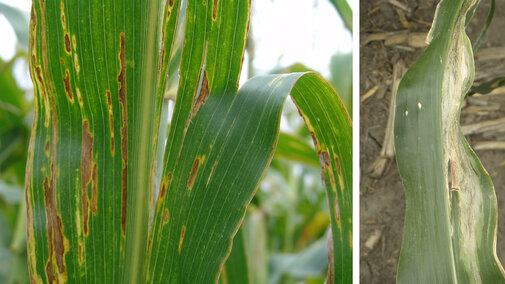Crop consultants have reported development of bacterial leaf streak disease in corn from Hamilton to Phelps to Dawson counties. This is approximately the date/crop stages when the disease was confirmed last year and it’s likely that the disease is developing elsewhere as well. Greenhouse and field experiments have demonstrated that the disease can develop in any corn growth stage.
Symptoms of of bacterial leaf streak include narrow interveinal, irregularly shaped tan to yellow lesions (Figure 1). Lesions are often yellowish in color when backlit. No treatment has been beneficial in field tests to date, so no treatment is recommended at this time to manage it. Foliar fungicides are not expected to control bacterial pathogens. The symptoms can be confused with those caused by other diseases, so please see additional resources below or submit a sample(s) to the UNL Plant and Pest Diagnostic Clinic for help identifying this or other diseases.
Damaged Corn Leaves Conducive to Other Diseases
Severe weather and wet conditions across much of Nebraska in recent days may favor more disease development in corn. In addition to bacterial leaf streak, Goss’s bacterial wilt and blight (Goss’s wilt) is especially favored by wounds created by hail, wind, sandblasting, etc. that can serve as infection points. Although Goss’s wilt has been less common in recent years in Nebraska fields, the pathogen can overwinter in infested crop debris and any fields with a history of the disease may see it develop again.
Goss’s wilt commonly causes larger watersoaked lesions that may have dark “freckles” on or near the edges (Figure 2). Less commonly, Goss’s wilt can also cause systemic wilt and premature death of plants, especially when they are wounded and infected by V6.
Diagnosis and Management
Diagnosing these diseases in the field may be difficult because symptoms may appear similar to those of some other diseases and because the bacteria are not visible to the naked eye. For a diagnosis, we recommend submitting samples to the UNL Plant and Pest Diagnostic Clinic.
Because these diseases are caused by bacterial pathogens, we do not expect foliar fungicides to directly control them. Some bactericides, such as those containing copper, are labeled for use in corn, but their effects have not been helpful controlling these diseases in the limited studies conducted. Activity of bactericides is often different than with foliar fungicides. For example, most bactericides are contact products and not systemic, so they won’t be absorbed by plants, in contrast to many common foliar fungicides. Thus, bactericides may be washed off with rain or overhead irrigation and might require repeated applications for control, making them uneconomical or impractical for use in some corn crops. Other common pest management strategies, such as crop rotation and/or tillage, may be helpful reducing disease severity, but such practices may not fit into all production systems and current research on their effectiveness has not been completed.
Sample Submission
If you are unsure of what you're finding, submit samples to the UNL Plant & Pest Diagnostic Clinic for help identifying this and other diseases.
For More Information
More information will be provided in later CropWatch issues summarizing research results and ongoing projects focused on bacterial leaf streak.

